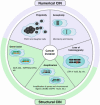Mutational drivers of cancer cell migration and invasion
- PMID: 33204027
- PMCID: PMC7784720
- DOI: 10.1038/s41416-020-01149-0
Mutational drivers of cancer cell migration and invasion
Abstract
Genomic instability and mutations underlie the hallmarks of cancer-genetic alterations determine cancer cell fate by affecting cell proliferation, apoptosis and immune response, and increasing data show that mutations are involved in metastasis, a crucial event in cancer progression and a life-threatening problem in cancer patients. Invasion is the first step in the metastatic cascade, when tumour cells acquire the ability to move, penetrate into the surrounding tissue and enter lymphatic and blood vessels in order to disseminate. A role for genetic alterations in invasion is not universally accepted, with sceptics arguing that cellular motility is related only to external factors such as hypoxia, chemoattractants and the rigidity of the extracellular matrix. However, increasing evidence shows that mutations might trigger and accelerate the migration and invasion of different types of cancer cells. In this review, we summarise data from published literature on the effect of chromosomal instability and genetic mutations on cancer cell migration and invasion.
Conflict of interest statement
The authors declare no competing interests.
Figures




References
Publication types
MeSH terms
Grants and funding
LinkOut - more resources
Full Text Sources
Medical

